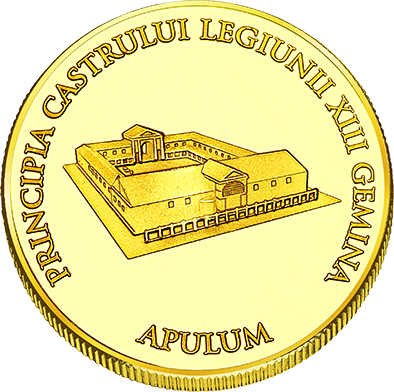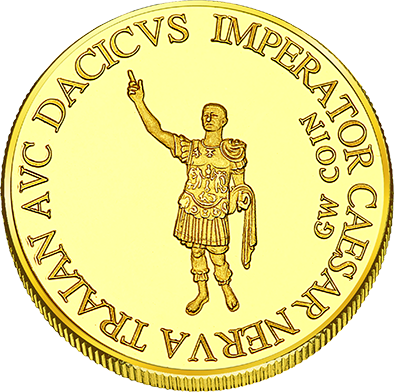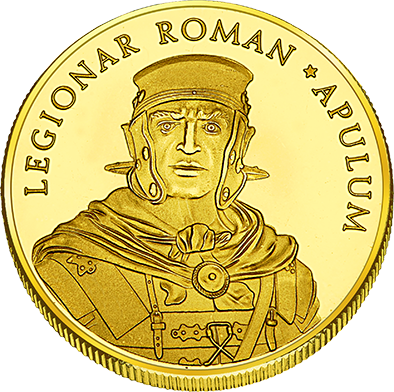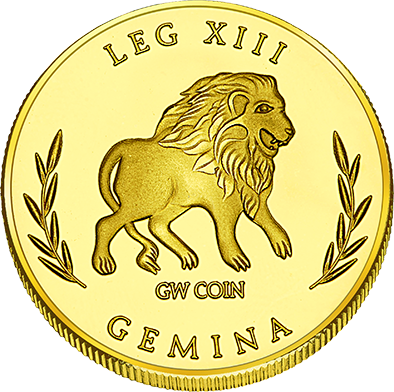EN
Located in the Citadel Square, the Principia Museum is the place where a part of the Principia building
of the Roman castrum in Apulum is touristically highlighted. The headquarters of the 13th Legion
Gemina was here, the 13th being the only legion that remained in Dacia province during the entire
period of Roman occupation. The museum is one of the places where you can find the story of the
castrum built by the Romans in Apulum. Principia was only partially researched and highlighted
because a large part of the ensemble is under the street near the „December 1st, 1918” University.
The exhibition in the museum courtyard presents artifacts discovered during the archaeological
research campaign in the area or from the older collections of the History Museum in Alba Iulia, that
is to say some statues and altars. The bronze statue at the entrance of the museum shows us how the
Roman soldier was equipped 1900 years ago, the times when Dacia became one of the last territories
included within the borders of the Roman Empire.
The inner area preserves in situ important traces of the Principia. The visitors can see the rooms where
the treasure and the standards were kept or the place where the briefing of the officers and of the
soldiers was performed. Also inside the original pavement of some rooms is highlighted or the
hypocaustum, the well-known heating system of the Romans.
You are probably wondering what were the reasons for choosing the five emperors whose bronze
statues are placed inside and outside the museum? All had an important role in the evolution of the
ancient Apulum but also for the history of the Roman empire in general. Traian was the one who
conquered Dacia. Under Hadrian the primary stages for the construction of the Apulum stone castrum
were initiated. Under Marcus Aurelius the first urban center in Apulum received the status of
municipium and Septimius Severus gave the same status to the second urban center in Apulum, the
one developed around the castrum.
The sources tell us about Caracalla that he arrived in Apulum accompanied by his mother (Iulia
Domna) around 213. Some medieval interpretations regarding the name „Alba Iulia” connect the name
with the name of this empress.
Inside the museum you can live a few moments from the life of a Roman soldier by being equipped
with the complex reconstruction replica of a military gear. Even more, the atmosphere of the ancient
world with its Roman legionnaires, Dacian warriors, gladiators and dancers is revived by the
reenactment group from Alba Iulia which has had a very intense public presence during the touristic
season.
The museum was opened for public in 2015 and it is a place where more and more events and
temporary exhibitions take place.
The traces of the Principia and other Roman objectives researched and highlighted in Alba Carolina
Citadel is part of the „European Cultural Route of the Roman emperors and wine along the Danube”.
RO
Amplasat în Piața Cetății, Muzeul Principia este locul în care este valorificată turistic o parte din
clădirea Principiei castrului roman de la Apulum. Aici și-a avut sediul comandamentul Legiunii a
XIII-a Gemina, singura legiune care a staționat pe teritoriul Daciei pe toată perioada ocupației romane.
Muzeul este unul dintre locurile în care puteți afla povestea castrului ridicat de romani la Apulum.
Principia a fost cercetată și pusă în valoare doar în parte, întrucât o bună parte a ansamblului se află
sub strada din apropiere și sub Universitatea „1 Decembrie 1918”.
În curtea muzeului sunt expuse piese descoperite în timpul campaniei de cercetare arheologică a zonei
sau din colecțiile mai vechi ale Muzeului de istorie din oraș, cum ar fi statui și altare. Statuia în bronz
de la intrarea în Muzeu ne arată cum era echipat soldatul roman acum 1900 de ani, atunci când Dacia a
devenit unul dintre ultimele teritorii incluse în granițele Imperiului roman.
Zona interioară păstrează in situ urme importante ale Principiei. Vizitatorii pot vedea încăperile în care
se ținea tezaurul, stindardele, unde se făcea instruirea ofițerilor și soldaților Legiunii. Tot în interior
este valorificată și pardoseala originală a unor încăperi sau hipocaustul, cunoscuta instalație de
încălzire a romanilor.
Vă întrebați, probabil, care au fost motivele alegerii celor cinci împărați romani, ale căror statui în
bronz sunt amplasate în interiorul și în curtea muzeului? Toți au avut un rol important în evoluția
anticului Apulum, dar și pentru istoria Imperiului roman, în general. Traian a fost cuceritorul Daciei.
În vremea lui Hadrian s-au derulat fazele inițiale ale existenței castrului de la Apulum. Sub Marc
Aureliu primul centru urban de la Apulum a primit statutul de municipiu, iar Septimius Severus a
acordat același statut pentru cel de-al doilea oraș de la Apulum, cel dezvoltat în jurul castrului. Despre
Caracalla se spune că a ajuns, cel mai probabil, și la Apulum în anul 213, alături de mama sa, Iulia
Domna. Unele interpretări medievale pe marginea denumirii de „Alba Iulia” chiar leagă orașul de
numele acestei împărătese.
Tot în Muzeu vă puteţi transpune pentru câteva momente în viaţă soldatului roman, prin îmbrăcarea
echipamentului complex ce a fost reconstituit. În plus, atmosfera lumii antice, cu legionari romani,
războinici daci, gladiatori și dansatoare este redată de trupa de reenactment antic ce activează în oraș și
care are o intensă prezență publică în cursul sezonului turistic.
Muzeul, deschis publicului din 2015, este și locul în care au loc tot mai multe evenimente și expoziții
temporare.
Urmele Principiei figurează, alături de alte obiective romane cercetate și valorificate în Cetatea Alba
Carolina, pe „Ruta culturală europeană a împăraților romani și a vinului de-a lungul Dunării”.




